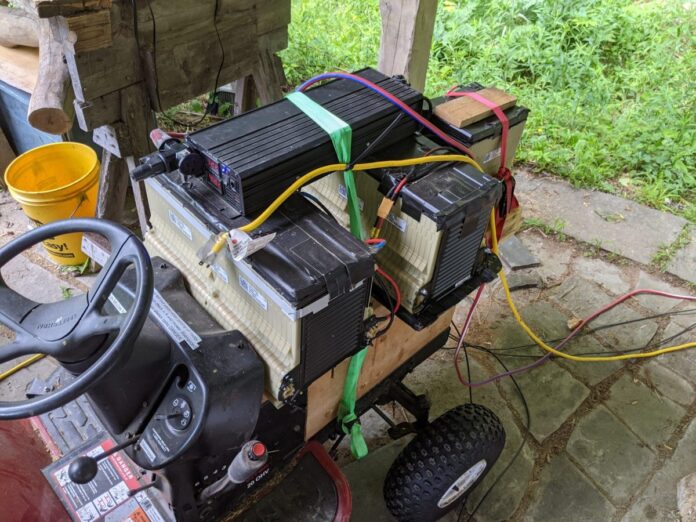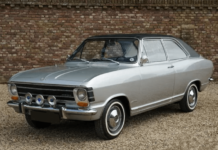[ad_1]
18 months ago I bought a Chevy Bolt for about 1/2 off sticker price. The Bolt has been awesome with the sole exception that I had no way to charge it at my wife’s house which is off grid and over an hour away from my house. As a side note I want to say that the key to a happy marriage is to have separate houses, I find that I really appreciate my wife when I go home and she is not around. When we are together all the time familiarity tends to breed contempt. I have been struggling to upgrade her old system which was only 1000W of panels when we met and about 1kWh of battery capacity. This is no where near enough to even consider charging an electric car. This article is about how I went about creating an off-grid system with 4kW of panels and 16kWh of batteries to charge an electric car and why I built it the way I did.

The current solar system was installed about 15 years ago and is a 24V DC based system. My wife had gone through up 3 sets of Lead Acid batteries in that time (two of them actually did pretty much blow up) and we decided to switch to Lithium. I wanted to separate the old system that ran the house with a new system that could run the house but would also work as a dedicated system for electric car charging. We plan to continue adding panels and want to install a hot water heat pump in the coming years, but the new panels with work with the new system.
The new system is based around an electric tractor I built using a salvaged Chevy Volt battery pack (how-to article here). The pack is 16kWh with about 14kWh usable. It is hooked up to a 3000W inverter and the solar charge controllers are also attached to the tractor. When I need to use the tractor or mow the lawn I just disconnect the solar panels and AC extension cords and do what I have to do then come back and plug it back in. We also use the tractor as a portable power station to run our electric log splitter, electric chainsaw and electric rototiller. The eTractor is stored outside since I am running the battery without a BMS and if it bursts into flames I don’t want it to take the house with it. I keep a large plastic bin over the batteries, inverter and charge controllers to keep the rain and snow off it. This bin helps the electronics stay warmer in the winter so they don’t get moisture buildup inside. This setup is the jankiest of jank, but it actually works pretty well and got us through last winter just fine.

Trying to charge an electric car without a large enough battery to absorb the ups and down of the sun peaking out behind clouds and such is a huge mistake. I would not consider trying to run an electric car charger off anything with less than 5kWh of battery capacity. I also much prefer the 48v systems because much lower amperage means you can use thinner copper wires between the inverter and the batteries. The only battery pack I recommend at this time is the EG4 server rack batteries from Signature Solar. I tried to buy LifePO4 batteries from China last year and it was the worst mistake of my life. You can get high quality server rack systems for about $297/kWh here which is almost as cheap as buying direct from China.
There is a bunch of all-in-one systems with the inverter and solar charge controllers built in which are super nice, many of them can be setup with a 240v setup as well (for level 2 charging which is ~5x faster). Will Prose’s DIY solar channel is the one to watch with new stuff getting tested and released all the time. I really like the setups he recommends but they are more expensive and have a 50-80w continuous vampire drain which I loath to have on our system. If you want one of the larger systems you will likely need to add 2 extra panels just to compensate for the constant drain of the higher power inverters. That being said the all in one systems are much, much nicer than anything I have ever whipped up and are a lot less likely to burst into flames. (if that sort of thing is important to you)

I built the new system with a Renogy Rover 60 Amp charge controller which I paid $297 for on ebay shipped and a 48v inverter I bought for $300 on Amazon here (this inverter has been shockingly reliable compared to the other cheap Chinese ones I have killed). This was hooked up to 2.6Kw of panels that I bought locally new for about 40 cents a watt off Craigslist. Figure another 10 cents a watt for roof mounting racks and the total for the whole system is ~$3900 ($1500 Volt battery + $300 MPPT charge controller + $300 inverter + $400 for copper wire + $40 DC circuit breakers + $40 MC4 crimpers and connectors + $280 roof rails + $1040 panels).
I have experimented with a cheap $40 PWM 30 amp charge controller from Amazon that I hooked up to the other 1.5kW of panels we have. It has worked surprisingly well for the price, but it is only about 80% efficient where the MPPT controller is over 95% efficient. At first I was super excited about the PWM controller, but it just really flounders on cloudy days whereas the MPPT controller works surprisingly well. There are two other PWM charge controllers with programmable charge limits I have bought and tried to work and both have died. The BSC3048 is the only one I can recommend at this time.

The crazy part is when you start comparing how many miles you need to drive to get your money paid back over just buying gas. If gas is $5/gal and your car gets 30mpg which most econo-crap-boxes the size of the Bolt get then after 24,000 miles of travel this system has completely paid for itself. ($4000/$5gal x 30 mpg = 24,000 miles) There is plenty of times in my life where I as driving more than 24,000 miles in just one year, so the payback for off-grid solar is there if you’re willing to absorb the higher purchase price of the vehicle. The biggest disadvantage is that using a system like this the recharging of the Bolt battery is pretty slow. I could charge at 12 amps (4 miles of range per hour), but I feel like that would stress the inverter so I only do it at 8 amps (3 miles of range per hour). Since most of the time the car is sitting around not doing anything this is really a non-issue. I don’t charge overnight, only when the sun is shining because I don’t really want to add more cycling to the Volt battery on the tractor.
With a little ingenuity and some elbow grease and a lot of luck you can setup an off-grid system to charge an electric car and kick gASS like I did. It’s pretty fun, rewarding and ends up making a lot of financial sense fo those of you who like playing the long game and are tired of getting shafted by big oil.
Ride On
[ad_2]
Source link















